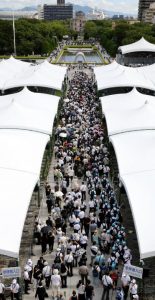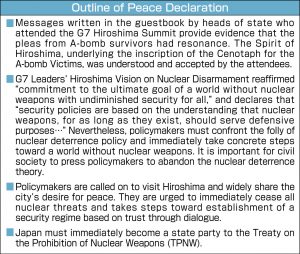Calling for rejection of nuclear deterrence theory, Hiroshima Peace Declaration on 78th anniversary of A-bombing demands security based on trust
Aug. 7, 2023
by Masanori Wada, Staff Writer
On August 6, 78 years after the atomic bombing of Hiroshima by the U.S. military, the Hiroshima City government held its Peace Memorial Ceremony at Peace Memorial Park, located in the city’s Naka Ward. The event marked the first A-bombing anniversary after the summit meeting of the G7 (Group of Seven industrialized nations), held in the city in May. Around 50,000 people (based on city numbers) attended the ceremony. Hiroshima City Mayor Kazumi Matsui used his Peace Declaration to urge policymakers to abandon the policy of nuclear deterrence and make progress toward a security regime based on trust.
Seating for around 7,000, twice the number as that at last year’s ceremony, were arranged for such participants as A-bomb survivors, representatives of bereaved families from 30 prefectures, government leaders including Prime Minister Fumio Kishida, and representatives of 111 countries around the world, the largest number of attending nations in history.
In the Peace Declaration, Mr. Matsui touched on certain aspects of the Hiroshima Vision on Nuclear Disarmament, a policy document issued at the G7 Hiroshima Summit. Those facets included a “commitment to the ultimate goal of a world without nuclear weapons with undiminished security for all” and firm adherence to the idea of nuclear deterrence. He cautioned, however, that “leaders around the world must confront the reality that nuclear threats now being voiced by certain policymakers reveal the folly of the nuclear deterrence theory. They must immediately take concrete steps to lead us from the dangerous present toward our ideal world.”
Mr. Matsui also asked members of the public to urge policymakers to break free of the policy of nuclear deterrence. He pressed Japan’s national government to immediately sign and ratify the Treaty on the Prohibition of Nuclear Weapons (TPNW). Hiroshima Prefectural Governor Hidehiko Yuzaki joined in the criticism of nuclear deterrence, saying in his remarks, “If it failed, would its believers be able to bear responsibility for the lives of all humankind?”
Meanwhile, Japan Prime Minister Kishida, raising such international issues as the nuclear threat posed by Russia, emphasized, “It is imperative for us to reinvigorate international momentum once more toward the realization of a ‘world without nuclear weapons’.” Mr. Kishida presented the Hiroshima Vision as an achievement of the G7 Hiroshima Summit.
During the ceremony, an A-bomb victims register, to which were added the names of 5,320 A-bomb survivors confirmed to have died in the previous 12 months, was presented at the Cenotaph for the A-bomb Victims. The register is now made up of 125 volumes listing the names of 339,227 victims. The attendees observed a moment of silence at 8:15 a.m., the exact time the atomic bomb was dropped on Hiroshima. Two sixth-grade children representatives read aloud their Commitment to Peace, pledging they would use their own words to convey the thoughts and wishes of the A-bomb survivors.
On the day of the ceremony, Hiroshima’s Naka Ward experienced the year’s highest temperature, reaching 36.9 degrees Celsius. According to the city’s fire department, two attendees at the ceremony thought to have been overwhelmed by heat were taken to the hospital.
(Originally published on August 7, 2023)
On August 6, 78 years after the atomic bombing of Hiroshima by the U.S. military, the Hiroshima City government held its Peace Memorial Ceremony at Peace Memorial Park, located in the city’s Naka Ward. The event marked the first A-bombing anniversary after the summit meeting of the G7 (Group of Seven industrialized nations), held in the city in May. Around 50,000 people (based on city numbers) attended the ceremony. Hiroshima City Mayor Kazumi Matsui used his Peace Declaration to urge policymakers to abandon the policy of nuclear deterrence and make progress toward a security regime based on trust.
Seating for around 7,000, twice the number as that at last year’s ceremony, were arranged for such participants as A-bomb survivors, representatives of bereaved families from 30 prefectures, government leaders including Prime Minister Fumio Kishida, and representatives of 111 countries around the world, the largest number of attending nations in history.
In the Peace Declaration, Mr. Matsui touched on certain aspects of the Hiroshima Vision on Nuclear Disarmament, a policy document issued at the G7 Hiroshima Summit. Those facets included a “commitment to the ultimate goal of a world without nuclear weapons with undiminished security for all” and firm adherence to the idea of nuclear deterrence. He cautioned, however, that “leaders around the world must confront the reality that nuclear threats now being voiced by certain policymakers reveal the folly of the nuclear deterrence theory. They must immediately take concrete steps to lead us from the dangerous present toward our ideal world.”
Mr. Matsui also asked members of the public to urge policymakers to break free of the policy of nuclear deterrence. He pressed Japan’s national government to immediately sign and ratify the Treaty on the Prohibition of Nuclear Weapons (TPNW). Hiroshima Prefectural Governor Hidehiko Yuzaki joined in the criticism of nuclear deterrence, saying in his remarks, “If it failed, would its believers be able to bear responsibility for the lives of all humankind?”
Meanwhile, Japan Prime Minister Kishida, raising such international issues as the nuclear threat posed by Russia, emphasized, “It is imperative for us to reinvigorate international momentum once more toward the realization of a ‘world without nuclear weapons’.” Mr. Kishida presented the Hiroshima Vision as an achievement of the G7 Hiroshima Summit.
During the ceremony, an A-bomb victims register, to which were added the names of 5,320 A-bomb survivors confirmed to have died in the previous 12 months, was presented at the Cenotaph for the A-bomb Victims. The register is now made up of 125 volumes listing the names of 339,227 victims. The attendees observed a moment of silence at 8:15 a.m., the exact time the atomic bomb was dropped on Hiroshima. Two sixth-grade children representatives read aloud their Commitment to Peace, pledging they would use their own words to convey the thoughts and wishes of the A-bomb survivors.
On the day of the ceremony, Hiroshima’s Naka Ward experienced the year’s highest temperature, reaching 36.9 degrees Celsius. According to the city’s fire department, two attendees at the ceremony thought to have been overwhelmed by heat were taken to the hospital.
(Originally published on August 7, 2023)









